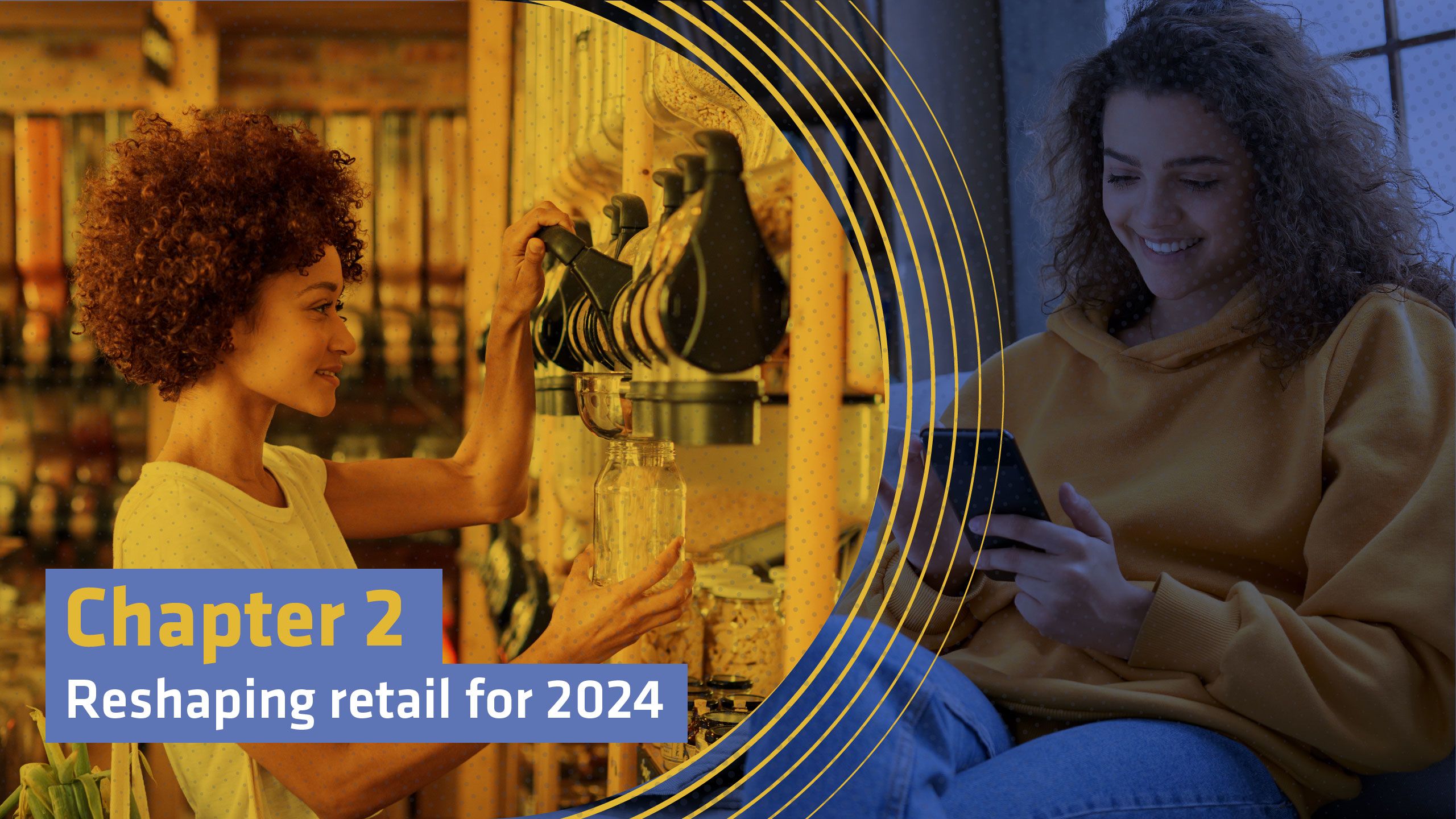
The structure of retail sales continues to fluctuate, but those many pandemic predictions of ecommerce establishing itself as the core shopping channel at the expense of physical retail have proved to be far wide of the mark.
The share of retail sales taking place online has slid from its pandemic high of 37.8% in January 2021 down to 24.9% in June 2023, according to the Office for National Statistics (ONS).
The ONS reported that non-food store sales rose by 1% in June 2023 while food store sales rose by 0.7%, showing that the store remains critical to consumer shopping journeys.
As Nick Hamblin, chief executive officer of Cotton Traders, tells us: “Through the pandemic, I wondered if we’d have any retail store sites left – I really did – and we did close a number.
“Talking to you today, all I want to do is find more and more [store locations]. It’s a really integral part of what we’re doing and I feel we’re really presenting ourselves in a better way than we ever have.”
As it stands, Cotton Traders has 85 stores – 59 concessions, typically in garden centres; 10 outlets; four travel stores at motorway service stations; and 12 on the high street.
However, online’s influence on the wider retail landscape is undisputed in terms of its use as a tool for research and comparison and to order items for store pick-up, for example – and ecommerce’s percentage of total UK retail sales is still up from its pre-pandemic 19%.
As a result, retailers continue to tweak how they manage sales across multiple channels. It is an ever-evolving landscape and requires businesses operating in this sector to be flexible and forward-thinking, and to combine channels in a sophisticated way.
As Leanne Cahill, chief executive of Bravissimo, says: “Seeing customers face to face is so important to our model, and I wondered to what extent physical retail was going to come back after the pandemic, but it really has bounced back and we’ve got a slightly stronger shop mix now than we had in 2018-19.
“It does really enable the online business because, once people have a great experience and know how good the fit is and what size they are, they can really confidently shop online – the store is an enabler for the whole business.”
Looking at the sales channel breakdown of the retailers we interviewed, online is set to have greater influence in the next 12 months, and even more so over the next three years. But it is incremental rather than revolutionary change.
The headline pair of statistics summarising the direction of travel are 75% saying online sales would either be the same or up year on year in 2024, while 66% said store sales would either be the same or down as a proportion of the overall mix. However, many interviewees were keen to stress that this did not mean stores sales were down; they are in fact growing.
The three-year outlook from the leaders surveyed found 75% saying online sales would either be the same or up on current levels and 63% saying store sales would either be the same or down on current levels.
These were the most common answers, emphasising how online is expected to creep up as a percentage of overall trade in the three years ahead, despite stores still maintaining an important role for retailers.
How store strategy is changing
Retailers increasing their store portfolio in the next 12 months include Bensons for Beds, Jollyes and Gift Universe. They currently have 165, 90 and 56 stores, respectively.
Paul Kraftman, chief executive of Gift Universe and Menkind, says it is difficult to predict where the online versus stores sales balance will settle.
However, he acknowledges that digital will grow in importance over the next three years. That said, he described current trading as “a shift back to physical”.
Joe Wykes, chief executive of pet specialist Jollyes, agrees stores play an “enormous” role in the success of his business, accounting for a trading figure in the high double digits. He agrees that physical retail represents the “hub” of the organisation and expects to roll out as many as 60 new stores between now and the end of 2024 – taking the Jollyes footprint from 90 to up to 150 shops.
EE, meanwhile, is currently experimenting with its new EE Studio stores. Bridget Lea, former managing director of commercial at EE, owned by BT, who was still in post when we interviewed her, said the plan was for EE’s physical spaces, particularly in big city locations, to become much larger and more experiential.
“We’ll move from that functional way of transacting with customers to a much more experiential way where we hope to encourage customers to come in, not just once every couple of years when they need to, but as often as possible when they want to learn more about technology,” Lea explained.
There is no clearly favoured location for new store openings, although high streets in primary locations such as London shopping districts or regional cities remain a focus for the interviewees.
Some 34% said they plan to maintain their store level in these areas, while 27% said they would like to add to their footprint there.
Convenience retailer Spar is looking to expand in this area and investing in different formats. Former managing director Louise Hoste, who left her role on September 8 but was in post at the time of our interview, said: “We are focusing on increasing our retail footprint, how to make stores bigger and improve the quality of the estate.”
Furniture retailer Bensons for Beds, which does not have stores on high streets or in primary locations such as London shopping districts or regional cities, is considering them in 2024 as part of a strategy to expand to 200 stores over the next two years.
The majority of these new stores would be in retail parks “in an ideal world,” according to chief executive Nick Collard, but the current availability of these sites makes that difficult.
One-fifth of retailers interviewed said they would like to open stores in retail parks, highlighting the current high demand for this space.
“The availability of stores [in retail parks] is a challenge, so we’re actually looking at other locations and smaller footprints – particularly within the M25,” Collard notes.
“That will be able to give us access to more markets, rather than waiting for a big store to suddenly turn up, which we might be waiting a long time for.”
Almost a quarter (24%) of retailers said they were looking to grow their portfolio in local high streets or areas known as secondary or tertiary locations.
The Works and garden centre chain Dobbies are among the companies looking to this destination for growth in 2024. The Works’ Peck says stores have a crucial role in “showcasing our value proposition and fulfilling our purpose, which is to inspire customers to read, learn, create and play”.
“They enable our passionate colleagues to interact directly with our customers, which we know is a hugely important part of the customer experience and helps to drive sales,” he explains, adding that investment in existing and new stores will continue in 2024.
Graeme Jenkins was chief executive of Dobbies at the time of our interview but stepped down in June, replaced by former Pets at Home chief operating officer David Robinson in July. When we spoke to him, Jenkins said growing the number of smaller-format Little Dobbies stores on high streets was a priority.
“They’re profitable in their own right, but it was about trying to get into people’s gardening lifecycle much earlier and we have seen that the demographic, the age profile, is much younger within Little Dobbies,” Jenkins said.


“It’s ultimately about providing the right level of communication. It works both ways, with feedback mechanisms in place, and many of those elements are key to really enabling the operation of the business”
Tech as an enabler
For many retailers, a key focus is digitising the store to boost operational efficiency, drive more compelling customer experiences and enable frontline staff to better do their jobs.
Lou Bennett, marketing director for UK and Ireland at Benefit, says the cosmetics brand’s biggest 2024 priorities are: “New technologies to power our people, serve our customer and accelerate the growth of our business, from automation tools to customer personalisation tools.”
Some 92% of retailers surveyed already have collaboration platforms such as Microsoft Teams, Zoom and Slack in place for store teams, while 78% use mobile devices for operations in the store environment and 70% have intranets to support interdepartmental communication.
Swarovski’s Ash says: “It’s ultimately about providing the right level of communication.
“It works both ways, with feedback mechanisms in place, and I think particularly now that we have a hybrid way of working, certainly for our office team too, many of those elements are key to really enabling the operation of the business.”
Tech currently lacking in store to enhance employee engagement includes dedicated task management software (only 32% have it) and voice communication/headsets (49%).
Pandora has an internal app used by all staff to drive better communication across the workforce.
“It’s a very easy and efficient way to get a message out to 3,000 people instantly,” says Brix. “The second you post something, you get reactions. You get a sense of: ‘Did we hit the mark here or not?’ Staff also provide feedback unprompted.”
Online focus
Online investment is on the priority list for most retailers, but for the digital natives it is crucial to keep evolving and refreshing to retain and recruit shoppers.
Never Fully Dressed founder Lucy Aylen says the number one priority for 2024 is “digital marketing via social platforms, newsletter and search”. She adds that social media marketing such as Instagram reels showcasing “multi-wear styles on diverse models” and “brand content showcased via paid ads, followed by product ads” has helped the fashion brand acquire new customers and influenced sales.
Reinforcing the uncertain environment many online retailers face in 2023 and the year ahead, as emphasised by the losses reported by Asos and Boohoo in 2023, WiggleCRC’s Crwys-Williams says investment will be “fairly conservative”.
“The investment we put in will all be into our front end, you know, customer experience, all online,” he says.
“We changed our whole technology stack this year so we have a very modern stack. It just means that effectively all the investment we do will be in front-end, CX features and functionality to make it better for visitors on our site.”
Daniel Blumire, joint managing director of Rapha, adds: “We want to do more, we want to bring the products and stories to life in a better way, so there’s definitely more we can do on the website.”
Multichannel jeweller F Hinds’ priority is investing in online marketing spend because the channel is starting to offer a bigger return on investment as it grows. However, traditional marketing still tops the list for the retailer.
Reflecting on its top five marketing channels in terms of investment, F Hinds chair Andrew Hinds says: “If you’re looking at this year as a whole, out-of-home is actually coming in top as we’re using it for new stores. Then it’s followed by SEO, PPC, email and then PR.”

Digital marketing is a key focus for Never Fully Dressed in 2024
Digital marketing is a key focus for Never Fully Dressed in 2024

“Not all our stores have headsets available for staff to use, but where they have gone in, it has really helped with communication within those stores”
Tech support
Another area attracting IT spend among the leaders we surveyed was tech support.
“On technology alone, we’re spending £1m to £1.5m every year, and we’re working with our parent company Kao on synergies of further automation and CX, just to make the experience far better,” says Anjun Murari, vice-president for global sales channels and strategic development at Molton Brown. “Investing in our website is an ongoing process.”
One of Seasalt’s key investments in 2024 is its ongoing enterprise resource planning (ERP) programme, which chief executive Paul Hayes describes as one of “the costliest” investments required in retail but “necessary to improve operations across the entire business”.
He says: “Essentially, it’s stability and functionality for the operation across the enterprise – it’s upgrading the likes of our finance systems and warehouse management systems. It links everything up and will enable us to integrate new technology faster and better, improving internal ways of working and our customers’ experience.”
When it comes to store technology, Spar’s former managing director Hoste told Retail Week, prior to leaving the company, that: “Not all our stores have headsets available for staff to use, but where they have gone in, it has really helped with communication within those stores.”
On the subject of data, Bensons for Beds’ Collard says: “A lot of our work at the moment is around joining up all of our varying data pools because we’re fairly rich in data, but have not been rich enough in terms of insight, so it’s about bringing those things together to give us better management information.”
Are retailers seeing clearly yet?
Of this year’s interviewees, 59% say they have a single view of stock in real time, 27% say they have a single view of stock but not in real time, and 10% say they do not have either.
Some 51% say they have a single view of their customer in real time, 27% say they have a single view of their customer but not in real time, and 22% say they do not have either.
Majestic Wine is one of the few retailers that says it has both a single view of stock and the customer. Chief executive John Colley says: “We have always had a customer database where we know where our customers live, what they drink, how frequently they shop, which shops they shop in, and which channels they prefer to use.”
“Along with our social media capability to really target customers, we have always had the ability to have a single view.”
Commenting on inventory management, Colley says a real-time stock system implemented in 2020 has combined well with Majestic’s Shop Local platform. “It means online customers are shopping real-time stock in their local store if they want to,” Colley explains.
“That's an innovation that has really changed our operating model because the margins that you make on a customer coming into the shop and buying something, or even delivering from a shop locally versus going through a third-party logistics pick-and-pack operation, are two totally different numbers.”
Gift Universe is also well positioned in terms of stock visibility, according to Kraftman, who agrees it is essential for retail businesses to maintain a clear view of inventory.
“We had somebody try to pitch us an inventory planning package and he was really impressed by the visibility and control we already have in place,” the chief executive explains.
“We have really good detail at line level, category level, margin, sell-through, so we have a very good handle on what’s going on. You can cut it any way you like; we have that visibility.”
On delivery, the most popular options already in place among the 41 UK retailers are next-day fulfilment (83%), buy in store and deliver to home (46%) and named-day fulfilment (41%).
Speedy and greener delivery represent the areas of focus going forward, with 32% of respondents saying they expect greater demand for more environmentally friendly delivery in 2024, and 29% and 27% expecting growing demand for next-day and same-day delivery respectively.
“I think eco-delivery option momentum will build next year,” says Beth Butterwick, chief executive of Jigsaw.
Ultimately, though, “the customer will shop how they want to shop,” says Fat Face’s Crumbie.
“I just think we need to create as many options as possible. I think the environmentally friendly eco-delivery options, for us, are a particular area where we think there are now really good services available in the market.”


“We will continue to look for areas that we can invest in, where we’ve potentially got gaps. It is all about understanding what our buyers want and sharing that info with sellers”
Delivery demands
When asked about the delivery trends they predict will dominate in the future, our leaders gave a variety of responses.
Convenience was key for many. “There’ll be individual customer types who will be more and more interested in personal delivery at a designated time and place,” says John Edgar, chief executive of Fenwick.
“I think that will become more and more important as shopping becomes like it was 150 years ago – very, very personal.”
Touker Suleyman, chief executive of Hawes & Curtis and star of the BBC investment pitching show Dragons’ Den, says: “What we plan to do is click and collect, and ‘click and alter’ as I call it. So people will buy suits, they will get them from the store, they’ll get a voucher to have alterations, the alterations will be done and they’ll then go back to the store to get suits.”
Moses Rashid, chief executive of The Edit LDN, an omnichannel marketplace selling limited-edition sneakers, clothing and luxury items, says: “It’s same-day and next-day delivery that really drive conversion for us, now equating to 30% of sales, and we’re putting more focus on that versus our competitors.”
When interviewed before he stepped down, Dobbies former chief executive Jenkins said: “We probably expect more same-day, next-day and click and collect from a third-party location in 2024.”
However, Eve Williams, vice-president and general manager for UK at eBay, summarises: “We will continue to look for areas that we can invest in, where we’ve potentially got gaps such as named-day delivery or two-man delivery for larger items, but it is all about understanding what our buyers want and sharing that info with sellers.”
For chapter 3, click on Cherry-picking investments below
